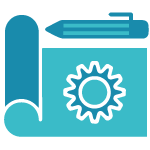Step by step guide for the implementation and assessment of Learning Sprints
Learning Sprints are short, intensive, time-bound periods of focused learning and development, typically undertaken by individuals or small collaborative teams, aimed at rapidly acquiring specific knowledge, developing a particular skill, or creating a tangible output (e.g., a prototype solution, a drafted protocol, a new learning resource) related to a well-defined AMR/AMS challenge or goal. Drawing inspiration from agile methodologies like Scrum in software development (Lang, 2017; Sigfridsson et al., 2007) and Design Sprints (Knapp et al., 2016, as cited in Raubenolt, 2016, and Arce et al., 2022), Learning Sprints emphasize iterative cycles of learning, doing, reflecting, and refining within a compressed timeframe (often ranging from a few hours to a few days, typically not exceeding one or two weeks). They promote active learning, collaborative problem-solving, rapid prototyping, and quick feedback loops.

Planning a Learning Sprints
The following steps should be taken into consideration when planning Learning Sprints on AMR/AMS:
- Define a Specific and Actionable AMR/AMS Challenge or Learning Goal: Clearly articulate a focused problem to solve, a specific skill to master, or a tangible output to create related to AMR/AMS (e.g., “Develop a prototype educational infographic for farmers on prudent AMU”, “Draft a new IPC checklist for ward X”, “Master the interpretation of a new AMR diagnostic test”, “Design a storyboard for a short AMR awareness video”). The goal must be achievable within the sprint’s short duration.
- Form a Small, Dedicated Team (if collaborative): Assemble a small, often interdisciplinary team (e.g., 3-7 members) with the necessary skills and perspectives to tackle the AMR/AMS challenge. Individual learning sprints are also possible for focused skill acquisition.
- Set a Strict Timeframe: Define a short, fixed duration for the sprint (e.g., a half-day, one day, three days, or a maximum of one to two weeks). This time constraint is crucial for maintaining focus and intensity. (Lang, 2017, describes “sprinting through the semester” with multiple short project cycles).
- Adopt a Structured Sprint Process: While adaptable, sprints often follow a structured process, particularly “Design Sprints,” which typically include phases such as:
- Understand/Define: Clearly understand the AMR/AMS problem, user needs, and constraints.
- Ideate/Sketch: Brainstorm and sketch a wide range of potential solutions or approaches.
- Decide: Converge on the most promising solution(s) to pursue.
- Prototype: Rapidly build a tangible, testable prototype of the solution (e.g., a draft infographic, a storyboard, a role-play script, a mock-up of an app feature).
- Test/Validate: Test the prototype with target users or experts to get quick feedback and identify areas for improvement. (Knapp et al.’s 5-day Design Sprint model is widely referenced, e.g., in Raubenolt, 2016, and Ferreira and Canedo, 2019).
- Incorporate Rapid Learning Cycles and Iteration: Learning Sprints involve short bursts of focused learning (acquiring necessary knowledge just-in-time), immediate application through doing/creating, and quick reflection/feedback loops to inform the next iteration or step.
- Expert Input and Resources: Ensure access to relevant AMR/AMS experts, data, guidelines, and tools as needed during the sprint.
- Conclude with a Tangible Output and Review: The sprint should result in a concrete deliverable. A review or “sprint retrospective” at the end allows the team to reflect on the process, outcomes, and learnings. (Lang, 2017, notes that a usable deliverable is planned, designed, built, tested, reviewed, and launched in each sprint).

Defining roles in a Learning Sprints
Facilitator’s role (Sprint Master/Coach/Lead Facilitator): Guide the team (or individual) through the structured sprint process, ensuring adherence to the timeline and methodology. Maintain focus on the sprint goal. Facilitate brainstorming, decision-making, and problem-solving. Remove obstacles and ensure the team has necessary resources. Protect the team from external distractions during the sprint. Foster a collaborative and high-energy environment. Guide the review and reflection process.
Participant’s role (Team Member/Learner): Fully commit to the intensive sprint period. Actively contribute expertise, ideas, and effort. Collaborate intensively with team members (if applicable). Engage in rapid cycles of learning, doing, and reflecting. Be open to new ideas, quick decision-making, and iterative refinement. Maintain focus on achieving the sprint goal within the set timeframe.

Assessing a Learning Sprints
Methods
- Evaluation of the Tangible Output: The primary assessment is often based on the quality, feasibility, and appropriateness of the deliverable produced during the sprint (e.g., the AMR infographic, the drafted protocol, the prototype app feature). (The “usable deliverable” is key in Lang’s (2017) agile learning approach).
- Process Observation and Peer Feedback: If team-based, observation of team dynamics, collaborative problem-solving skills, and contributions of individual members. Peer feedback can be incorporated.
- Participant Self-Reflection and Feedback: Collection of participant feedback on the sprint process itself, the learning experience, the effectiveness of the methodology for achieving the goal, and skills gained.
- Knowledge/Skill Application: If the sprint focused on skill acquisition, practical demonstration of the skill post-sprint could be assessed.
- User Testing Feedback (for Design Sprints): If a prototype is tested with end-users, their feedback is a critical assessment of the solution’s viability.
Tools
Sprint backlog or task board (e.g., using software such as Trello or Jira, or a physical whiteboard) for managing tasks and progress. Prototype evaluation rubrics or checklists. Peer assessment forms. Facilitator observation notes. User testing protocols and feedback forms. Post-sprint retrospective questionnaires

Suggested Learning Sprints prototype
Target Audience: Researchers, Educators, Prescribers, Dispensers, Clinical Profiles.
Learning Objectives:
- Collaboratively design a clear, concise, and patient-friendly educational leaflet on a specific AMR/AMS topic (e.g., “Why antibiotics don’t work for colds/flu,” “How to take your antibiotics correctly,” “Preventing infections to reduce antibiotic need”) in a rapid timeframe.
- Apply principles of health literacy and effective communication for patient education related to AMR.
- Experience an intensive, iterative, and user-centered design process.
- Develop interprofessional teamwork and rapid prototyping skills.
Curriculum/Activities (e.g., a 2-day Design Sprint):
- Team Formation: Small interprofessional teams of students (e.g., medical, pharmacy, nursing students).
- Day 1: Understand, Define, Ideate:
- Understand: Brief expert input on the specific AMR/AMS topic and principles of health literacy. Review examples of existing patient leaflets (good and bad).
- Define: Clearly define the target audience for the leaflet, key messages, and desired patient action.
- Ideate: Brainstorm content, layout, and visual ideas for the leaflet. Sketch multiple concepts individually and then share and critique as a team.
- Day 2: Decide, Prototype, Test and Refine:
- Decide: Select the most promising leaflet concept as a team.
- Prototype: Rapidly create a low-fidelity prototype of the leaflet (e.g., hand-drawn or using simple design software).
- Test: (Ideally) Test the prototype with a few representative “patients” (e.g., other students, community members if available) for clarity, understanding, and appeal, gathering quick feedback.
- Refine and Present: Iterate on the prototype based on feedback. Prepare a final version (or near-final draft) of the leaflet and present it to peers and facilitators, explaining their design choices and testing insights.
Evaluation of the Prototype’s Effectiveness:
- Assessment of the final prototyped AMR patient leaflet based on criteria such as clarity, accuracy of AMR/AMS information, adherence to health literacy principles, visual appeal, and potential effectiveness for the target audience.
- Peer and facilitator feedback on the design process and the final leaflet.
- Participant self-reflection on the learning experience, teamwork, and skills gained in rapid design and communication.
- (If tested with users) Summary of user feedback on the leaflet prototype’s comprehensibility and usefulness.
References
- Raubenolt, A. (2016). An Analysis of Collaborative Problem-Solving Mechanisms in Sponsored Projects: Applying the 5-Day Sprint Model. Journal of Research Administration, 47(2), 94-111. https://eric.ed.gov/?id=EJ1152255
- Aguado, G., Fernández, C., Garreta-Domingo, M., Griset, R., & Valls, A. (2014). Course Sprints: Combining Teacher Training, Design Thinking and Hackathons. In P. Zaphiris, & A. Ioannou (eds). Learning and Collaboration Technologies. Designing and Developing Novel Learning Experiences. LCT 2014. Lecture Notes in Computer Science (pp. 3–12). Springer International Publishing. https://doi.org/10.1007/978-3-319-07482-5_1
- Arce, E., Suárez-García, A., López-Vázquez, J. A., & Fernández-Ibáñez, M. I. (2022). Design Sprint: Enhancing STEAM and engineering education through agile prototyping and testing ideas. Thinking Skills and Creativity, 44, 101039. https://doi.org/10.1016/j.tsc.2022.101039
- Beyer, J., Yang, Y., & Pfister, H. (2021). Visualization Design Sprints for Online and On-Campus Courses. IEEE Computer Graphics and Applications, 41(6), 37–47. https://doi.org/10.1109/mcg.2021.3115413
- Ferreira, V. G., & Canedo, E. D. (2019). Using design sprint as a facilitator in active learning for students i n the requirements engineering course. In Proceedings of the 34th ACM/SIGAPP Symposium on Applied Computing (pp. 1852–1859). https://doi.org/10.1145/3297280.3297463
- G., L. (2017). Agile Learning: Sprinting through the Semester. Information Systems Education Journal, 15(3), 14-21. https://eric.ed.gov/?id=EJ1140882
- Priyono Haryadi, A., & Juliane, C. (2022). IMPLEMENTATION OF SPRINT LIFE CYCLE FROM AGILE METHODOLOGY WITH KNOWLEDGE MANAGEMENT CYCLE. Jurnal Teknik Informatika (JUTIF), 3(5), 1439–1447. https://doi.org/10.20884/1.jutif.2022.3.5.288
- Sigfridsson, A., Avram, G., Sheehan, A., & Sullivan, D. K. (2007). Sprint-driven development: Working, learning and the process of enculturation in the PyPy community. In IFIP — The International Federation for Information Processing (pp. 133–146). Springer US. https://doi.org/10.1007/978-0-387-72486-7_11
- Skaar, J. (2023). SPRINT TOWARDS A SUSTAINABLE FUTURE. In DS 123: Proceedings of the International Conference on Engineering and Product Design Education (E&PDE 2023). https://doi.org/10.35199/epde.2023.65
- Thomas, J., & Strickfaden, M. (2018). From Industrial Design Education to Practice: Creating Discipline Through Design Sprints. In Advances in Intelligent Systems and Computing (pp. 111–121). Springer International Publishing. https://doi.org/10.1007/978-3-319-94601-6_13
